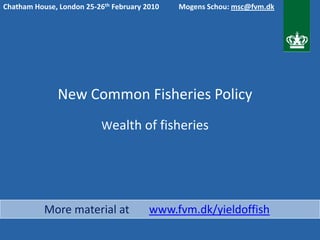The document discusses potential reforms to the Common Fisheries Policy to optimize fisheries management and maximize economic benefits. It proposes introducing individual transferable quotas (ITQs) to balance fishing capacity with available resources and incentivize sustainable practices. Additionally, it suggests implementing catch quota management (CQM) using CCTV and catch accounting to replace the incentive to discard fish with incentives for selective fishing and utilizing total catches. Modeling indicates ITQs could generate economic gains, which CQM could further improve by providing reliable catch data for management and incentivizing reduced discards. The document advocates testing these approaches gradually to realize their benefits while accommodating national priorities.




















